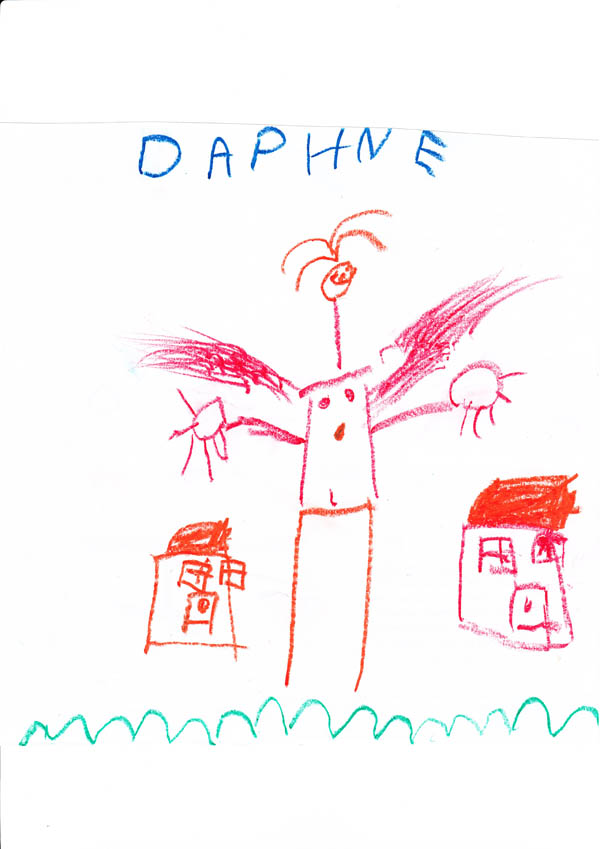He proudly offers them to you. A bit perplexed, you display them on the door of the refrigerator… What do they really say about him?
- Home
- Expert advice
- Interpreting your child's first drawings

1. Some key points to understand
Children reveal themselves through graphic productions. The subjects, the colors, the drawing provide valuable information to psychologists. Take a step back before undertaking any analysis, and weigh your conclusions: like dream interpretation, the interpretation of drawings is not an exact science!
- Observe his work in its entirety: density, number of colors, etc.
- Place it in it's context: work done at school, following an event, etc.
- Recall if it was spontaneous, translating his mood of the moment.
- Study the proportions: children make large the aspects that are important in their eyes.
In practice: some basic errors
- Repetition does not necessarily indicate a problem. Perhaps he reproduces the same subject because you congratulated it the first time.
- Talent: you see a magnificent tortoise in a multicolored mosaic... while he was only experimenting with his new box of paints.
- Genius: if he suddenly draws a "blue planet" at age 4, it is surely the subject of a school workshop.
- Literal interpretation: not all children who represent themselves surrounded by two houses are torn between two estranged parents!
2. The meaning of the current fugures
- Character (his): the size of the eyes reveal his curiosity, the size of the mouth reveals his capacity to verbalize his emotions. Arms raised, he is asking to be heard; lowered, he is seeking tranquility. Feet anchored on the ground signify stability.
- House (his universe): the bigger it is, the more he is at ease. The number of windows signifies his degree of openness. Without access underlines a sense of failure.
- Sun: sign of energy, it represents the mother to the left of the sheet, and the father to the right.
- And also: tree (force, anchored in his environment), animals (emotions), water (femininity, birth), land (attachment to the mother), sky (aspirations, dreams) etc.
3. Zoom on the colors
He uses more than three, he is dynamic and open to others. He is happy with one or two colors: he is going through a period of looking inward.
- Red: it is the favorite color of young children. Later, it channels energy, but also anger and aggression.
- Yellow: optimism, knowledge... it is the color of curious and expressive children.
- Blue: sign of peace and harmony, it underlines a need to advance at his own pace.
- Green: it is associated with maturity and intuition.
- Black: With young children it is more of a sign of self confidence. Later on, it is associated with anguish.
- And also: pink (tenderness), orange (team spirit), brown (attention to detail, security)...
Memo: The characteristics of the drawing
- The drawing: a confident line indicates relaxed. Hesitant, suggests fear of being judged. A fine line is a sign of great sensitivity; a thicker line denotes energy.
- Use of space: the more the sheet is filled, the more the child has confidence in his future. A nearly blank page reveals timidity.
- Positioning of the subjects: a confident child represents himself at the center of his world.
- Organization of the subjects: if he draws his family, the size and proximity of the people has significance.
Recommended product:
White drawing paper
See also :
For kids
Playing with one's children
Explore more tutorials on this technique
For kids
Making an Easter bunny
For kids
Make a present for Mother's Day
For kids
Create a paper pencil pot
For kids
Create masks
For kids
Make a Valentine's Day Gift
For kids
Make expressive faces out of paper
For kids
Make a corrugated cardboard parrot
For kids
Create corrugated cardboard totems
For kids
Create a paper mandala
For kids
Making a paper hot-air balloon
For kids
Make a 3D paper landscape
For kids
Make a paper mâché globe
For kids
Create a garland for April Fools Day
For kids
Make 3D toys out of paper
For kids
Make a chronological frieze
For kids
Make a paper cactus
For kids
Make a silhouette card
For kids
Making corrugated cardboard arrows
For kids
Drawing a Horse
For kids
Making a secret egg box from card
For kids
Drawing a boat
For kids
Create a botanical book
For kids
Create a four seasons picture
For kids
Create a star mosaic
For kids
Create a beautiful glittering star
For kids
Making a snowflake
For kids
Create a shape memory game
For kids
Drawing a Happy Dolphin
For kids
Drawing a Playful Dolphin
For kids
Drawing a Knight on Horseback
For kids
Drawing children
For kids
Drawing a Griffin
For kids
Drawing a Penguin
For kids
Drawing a Horse and Cart
For kids
Draw a soldier
For kids
Drawing a Foal
For kids
Drawing a turtle
For kids
How to make ladybirds
For kids
Drawing a castle
For kids
Set off to discover modern history
For kids
Create a pop-up card
For kids
Activities for kids: Drawing a cat
For kids
Activities for kids: Graffiti
For kids
Activities for kids: Drawing a horse
For kids
Activities for kids: Drawing a hand
For kids
Playing with one's children
For kids
Your children's graphic development
For kids
Drawing a Dragon
